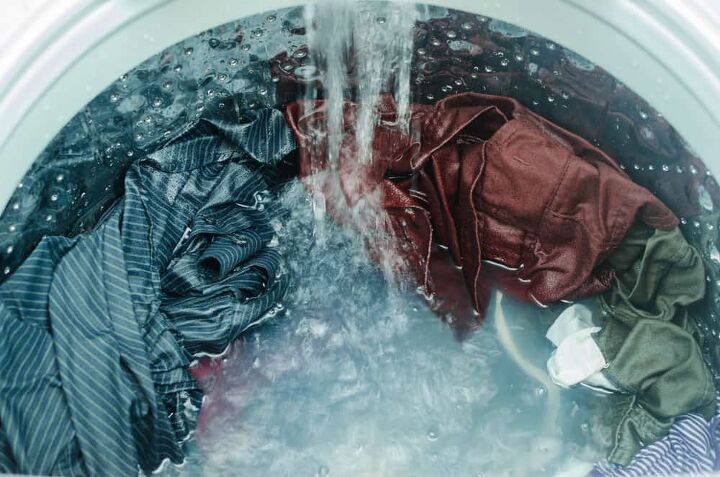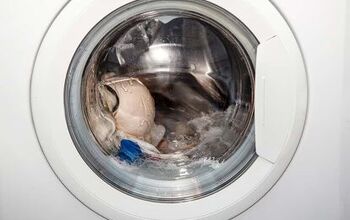Washing Machine Drain Overflows? (Here's a Fix)

Did you know washing machines use between 14 and 20 gallons of water per load? Now, imagine all that water overflowing onto your laundry room floor! No one wants that, but unfortunately, the washing machine drain overflows on occasion.
There are several reasons your washing machine might overflow. But usually, a washing machine drain overflows when the drainpipe behind the washer is clogged. This area is where the discharge hose fits in. Debris and residue build up in the pipe causing water leakage.
To fix the problem, first, move the washing machine away from the wall. There are several methods to clear a blockage depending on what it is.
Do You Need Appliance Installation or Replacement?
Get free, zero-commitment quotes from pro contractors near you.

How a Washing Machine Works
During a wash cycle, your washer sends dirty water to the main sewer line to make room for clean water. At the back of your washing machine sits an outlet tub with a flexible hose attached. This is called the discharge hose. The dirty water funnels through the discharge hose to a drainpipe that’s connected to the main sewer line.
What Causes Washing Machine Drain Overflow?
The most common reason a washing machine drain overflows is due to a clogged drainpipe. As the machine washes your clothes, debris, like lint, goes through the discharge hose along with the dirty water. Sometimes, this debris gets caught in the pipe, causing it to back up.
Clogging typically means something is stuck and causing a blockage. Regular cleaning prevents this. But occasionally, foreign objects or debris get stuck because of improper installation or washing machine defects. The following video explains this in more detail.
How to Detect a Clogged Washer Hose
Hopefully, detecting a clog in your washer is much less dramatic than a flooded laundry room floor. Sometimes, our washers give us hints that there’s a problem before it gets to that point.
One of the biggest indications your washer hose is clogged is if the water sits in the drum for a long time after a cycle is finished. You can also perform a quick test by pouring a cup of water down the drain. If you notice any leaks, this is an early sign that the drain is clogged.
What to Do When a Washing Machine Drain Overflows
When a washing machine drain overflows, there are, fortunately, easy steps to fix it. First and foremost, if your washer is actively overflowing, shut off your water so the problem doesn’t get bigger. Then, dry the area thoroughly to prevent water damage. Follow the steps below to get to work.
It’s always recommended to call in a professional plumber if you feel at all uncomfortable doing it yourself.
Step 1: Create space between the washer and the wall.
The washer’s discharge hose is found behind the washing machine. The drainpipe that’s connected to the discharge hose is in the wall. To access both, move the washer away from the wall, and give yourself enough space to work.
Step 2: Prep the area.
It’s always a good idea to prepare your workspace, especially when a potential water overflow is an option. Lay a drop cloth to collect any water leakage or small particles that were stuck in the hose.
To entirely avoid water spills, a water pump may also be used. However, if you choose to use a water pump, you need an intake hose running into the clogged drain and an outlet draining elsewhere.
Step 3: Unclog the drainpipe.
There are a few different methods that may work to unclog the drain behind your washing machine. The methods depend on what’s causing the clog. Common methods include using an auger, chemicals, and natural home remedies, like hot water.
AugersThe most common method to unclog a drain is to use an auger. Also known as a snake, it’s a mechanical device that can physically remove any debris that is blocking water drainage.
There are several different types of augurs you can use to clear a drainpipe behind a washing machine. Some augurs are hand-operated while others are powered by a drill or similar tool.
- Hand-operated augers are generally lightweight, inexpensive, and easy to store when not in use. The main downside with hand-operated augurs is that operating them requires some manual labor. For some, snaking a drain by hand can prove to be inconvenient and difficult.
- Machine-operated augers come in many shapes and sizes and are much easier to use than their hand-operated counterparts. They clean drains more efficiently due to their metal wires that spin at high speeds to remove debris. To use a machine-operated auger, insert the end of it into the drainpipe. Agitate the wires with the drill or hand motor, and then slowly feed it deeper into the drain until the clogged is released.
For some, using chemical agents, such as Drano and other similar products, is the most convenient method for unclogging drains. Using chemicals has its limitations when compared to an auger. But for some types of clogs, the right chemical treatment can work wonders.
To use a chemical agent for clearing the washing machine drain, it is always important to read the usage instructions on the bottle thoroughly. Chemicals used to unclog drains are powerful. Following the manufacturer’s usage recommendations keeps you safe when unclogging the drain.
Though each product is different, many of them require time to sit in the drain before flushing with water. Detergents or dish soap may also be used to unclog a drain, but solutions with stronger chemicals are recommended.
Natural Home RemediesFor those who wish for an eco-friendly solution to unclog a drain, there are several options. In certain situations, flushing the line with boiling water and soap unclogs a drain. Vinegar and hydrogen peroxide solutions are also quite effective.
Using natural methods to clear drains may not yield results as long-lasting as the methods above. Home remedies are far cheaper than some of the more effective methods. But you may have to repeat the process more often.
The effectiveness of home remedies has a lot to do with the type of blockage that exists in the drain. If the blockage is caused by hair and other tough materials, hot water does little in terms of a long-term solution. On the other hand, if the blockage is caused by soap and lint buildup, very hot water may flush out the drain just fine.
Step 4: Reinsert the washing machine hose into the drain.
It’s always a good idea to test the drain to make sure that the blockage has been removed. Reinsert the washing machine drainage tube into the drain. Then, run several rinse-and-spin cycles without laundry. Observe the drain pipe for leaks.
You’ll know the problem is resolved when the washing machine water successfully drains with no backup. Or the cycle completed without any leaks. At this point, you can remove the drop cloth and put the washer back in place.
If the water isn’t draining properly, you’re not in the clear yet. Check for obstructions under the washer or around the drainpipe. Sometimes, water backup happens if a drain is moved. Try relocating it to its original place, or call a plumber for help.
Preventative Measures
To prevent washing machine drain overflows, there are a few precautions to take.
- Clean and maintain your washing machine hose. Manufacturers recommend homeowners disconnect and clean their washer hoses at least once a year. Replace them after five years for the best results.
- Use a garment bag during a wash cycle. Putting your clothes in a garment or lint bag reduces the amount of lint and fabric particles that go into the hose.
- Clean the lint trap. Some washing machines have a lint trap that catches lint during a wash cycle. This is the washer’s first line of defense in keeping lint out of the drainpipe. If yours has a lint trap, clean it at least once a month.
- Check for proper hose and pipe clearance. There should be at least half an inch of clearance between the discharge hose and drainpipe. This clearance allows for the proper ventilation needed during drainage.
- Check for a firmly attached hose. If the discharge hose is not firmly attached to the drainpipe, the washer’s vibrations may cause it to come loose.
Why Does My Washing Machine Drain So Fast?
Occasionally, you may come across the opposite problem: a washing machine that drains too fast. This usually happens because the water flows out of the washer faster than the pipe can drain.
For this fix, you need to restrict the water flow so it slows down. This gives the drain additional time to handle the water discharge. There are several options to restrict water flow, including making or buying a flow restrictor.
Do You Need Appliance Installation or Replacement?
Get free, zero-commitment quotes from pro contractors near you.

Conclusion
A clog is the most common reason we see washing machine drain overflows. Since clogs take time to build up, it’s possible to address the issue before it becomes a total flood. As soon as you recognize a clog, you should take action to prevent excessive water damage.
Clear the blockage using any of the several methods mentioned in this article, or better yet, call in a professional.
Related Guides

Benjamin is a proud homeowner who loves to write about DIY projects and home improvement projects. Traveling, perfecting his home, and spending time with his family are just a few of the many things that keep him inspired.
More by Benjamin Wright

























![How To Reset A Whirlpool Cabrio Washer [In 5 Easy Steps!]](https://cdn-fastly.upgradedhome.com/media/2023/07/31/9076531/how-to-reset-a-whirlpool-cabrio-washer-in-5-easy-steps.jpg?size=350x220)

